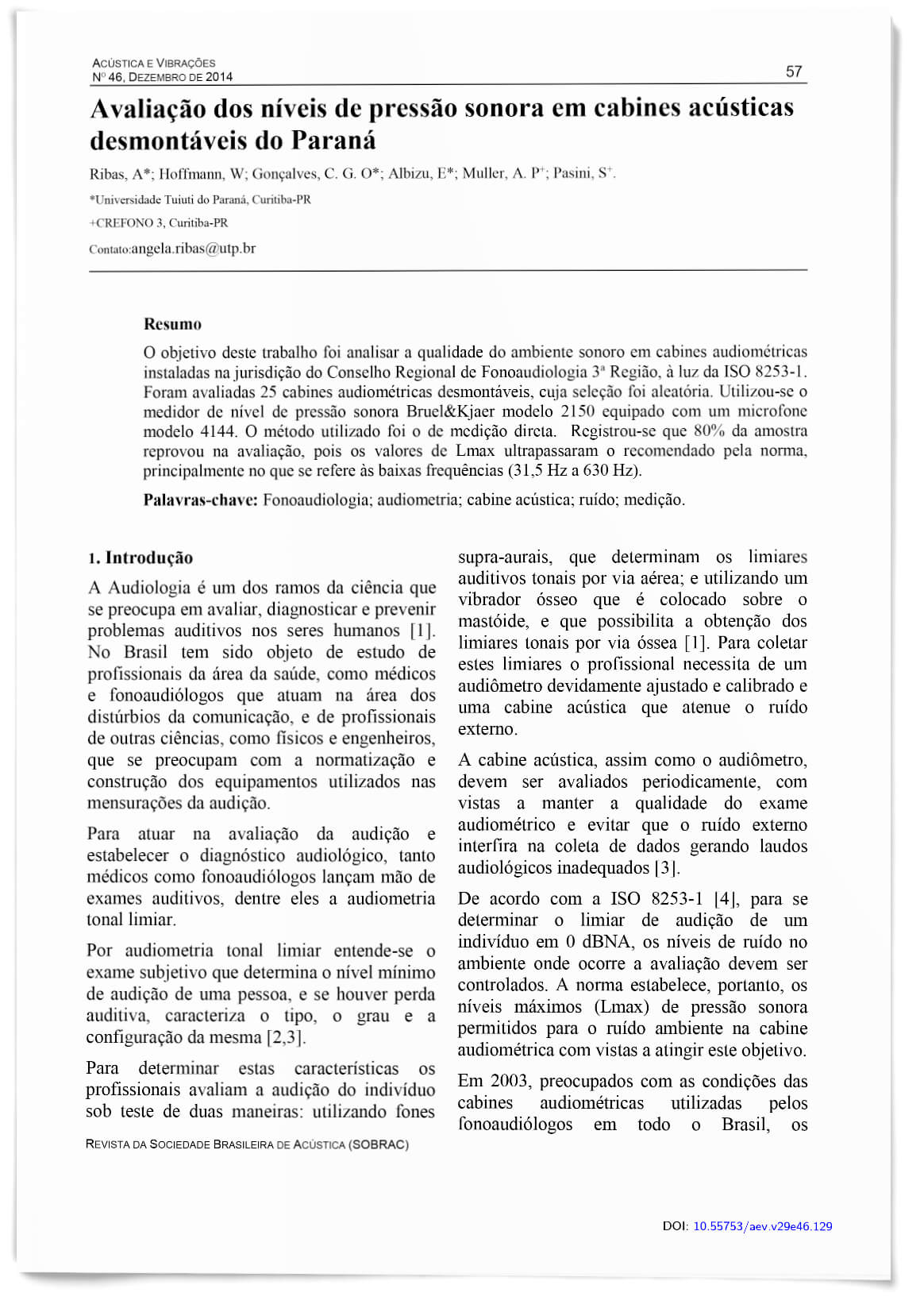Influence of the Size of the Openings on the Acoustic Quality of Naturally Ventilated Classrooms
DOI:
https://doi.org/10.55753/aev.v29e46.128Keywords:
acoustic quality, computer simulation, classrooms, openings, windowsAbstract
The acoustic conditions of classrooms can directly interfere in the teaching and learning process. Some constructive components can influence in such conditions. In hot-humid climates, openings are used for the main purpose of providing natural ventilation. Conflict situations between the needs of environmental comfort can be verified when such components also allow the entry of external noise, causing a decrease in sound insulation. In addition to aspects related to insulation and ventilation, it is necessary to address the interference of openings in the internal acoustic quality. In this context, the present work aims to evaluate the influence of the size of the openings on the acoustic quality of naturally ventilated classrooms based on the municipal public education network in Maceió-AL. The methodology consisted of parametric analysis, based on the results of acoustic quality parameters: Reverberation Time (TR), Clarity (C50), Speech Transmission Index (STI) and Percentage of Consonant Articulation Loss (%ALCons), obtained through computer simulation. Through the results, it was observed that the increase in the opening area leads to significant improvements in the values of acoustic parameters. Knowledge about the effect of openings on internal acoustic quality can help architectural design in the decision-making process by architects.
References
ABNT - ASSOCIAÇÃO BRASILEIRA DE NORMAS TÉCNICAS. NBR 15220 – Desempenho térmico de edificações (partes 1, 2 e 3). Rio de Janeiro: ABNT, 2005.
__________. NBR 12179 – Tratamento acústico em recintos fechados. Rio de Janeiro: ABNT, 1992.
AMORIM, A. E. B. Formas geométricas e qualidade acústica de salas de aula: estudo de caso em Campinas-SP. Dissertação (Mestrado). Pós- graduação da Faculdade de Engenharia Civil, Arquitetura e Urbanismo. Universidade Estadual de Campinas. Campinas, 2007.
ANSI - AMERICAN NATIONAL STANDARD. ANSI S12.60: Acoustical Performance Criteria, Design Requirements, and Guidelines for Schools. Accredited Standards Committee S12, Noise. Standards Secretariat Acoustical Society of America, Melville, NY: American National Standards Institute, Inc, 2002, 50p.
ARAÚJO, B. C. D. de. Proposta de elemento vazado acústico. Tese (Doutorado). Programa de Pós- Graduação em Arquitetura e Urbanismo. Universidade de São Paulo. São Paulo, 2010.
BISTAFA, S. R. Acústica Aplicada ao Controle do Ruído. São Paulo: Edgard Blücher, 2006. 368p.
EGAN, M. David. Architectural Acoustics. New York: McGraw-Hill, 1988. 411p.
EYRING, C. F. Reverberation time in “dead” rooms. Journal of the Acoustical Society of America- JASA. v.1, p.217-241, 1930. DOI: https://doi.org/10.1121/1.1915175
GERGES, S. N. Y. Ruído: fundamentos e controle.2.ed. Florianópolis: NR Editora, UFSC, 2000. 696p.
IEC - INTERNACIONAL ELETROTECHINICAL COMMISSION. IEC 60268-16: Sound system equipment – Part 16: Objective Rating of Speech Intelligibility by Speech Transmission Index, 2011.
INEP - Instituto Nacional de Estudos e Pesquisas Educacionais Anísio Teixeira. Data Escola Brasil. Disponível em:<http://www.dataescolabrasil.inep.gov.br/dataEscolaBrasil/> . Acesso em: 01/05/2014.
KUTTRUFF, H. Room Acoustics. 2.ed. London, UK: Applied Science Publishers LTD.,1979. 300p. doi: 10.1016/0003-682X(80)90032-8 DOI: https://doi.org/10.1016/0003-682X(80)90032-8
MARSHALL, L. G. An acoustics measurement program for evaluating auditoriums based on the early/late sound energy ratio. Journal of the Acoustical Society of America-JASA. v. 96, p.2251-2261, 1994. DOI: https://doi.org/10.1121/1.410097
MARTELLOTTA, F. On the sound absorption by openings in rooms (L). Journal of the Acoustical Society of America-JASA. v. 132, n.5, p. 2951–2954, 2012. doi: 10.1121/1.4756923 DOI: https://doi.org/10.1121/1.4756923
MEC - MINISTÉRIO DA EDUCAÇÃO E CULTURA. Espaços educativos – ensino fundamental: subsídios para elaboração de projetos e adequação de edificações escolares. Cadernos técnicos, n. 4, v.2. Brasília: FUNDESCOLA, 2002.
MEHTA, M.; JOHNSON, J.; ROCAFORT, J. Architectural acoustics: principles and design. Columbus: Prentice Hall, 1999. 446p.
OITICICA, M. L. G. da R. Desempenho acústico de diferentes tipologias de peitoris ventilados. Tese (Doutorado). Pós-graduação da Faculdade de Engenharia Civil, Arquitetura e Urbanismo. Universidade Estadual de Campinas. Campinas,2010.
SABINE, W. C. Collected Papers on Acoustics. Cambridge, MA: Harvard University Press, 1922. doi: 10.1121/1.3072523 DOI: https://doi.org/10.1121/1.3072523
SAUTER, A.; SOROKA, W. W. Sound transmission through rectangular slots of finite depth between reverberant rooms. Journal of the AcousticalSociety of America-JASA. v. 47, n.1, p.5–11, 1970. doi: 10.1121/1.1970289 DOI: https://doi.org/10.1121/1.1911442
SGARD, F; H. NELISSE, H.; ATALLA, N. On the modeling of the diffuse field sound transmission loss of finite thickness apertures. Journal of the Acoustical Society of America-JASA. v. 12, n.1, p.302–313, 2007. doi: 10.1121/1.2735109 DOI: https://doi.org/10.1121/1.2735109
WILSON, G. P.; SOROKA, W. W. Approximation to the diffraction of sound by a circular aperture in a rigid wall of finite thickness. Journal of the Acoustical Society of America-JASA. v. 37, n.2, 1965, p.287–297. DOI: https://doi.org/10.1121/1.1909325

Published
How to Cite
Issue
Section
License
Copyright (c) 2014 Acústica e Vibrações

This work is licensed under a Creative Commons Attribution-NonCommercial-ShareAlike 4.0 International License.




